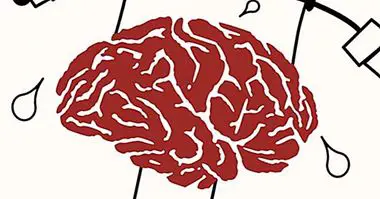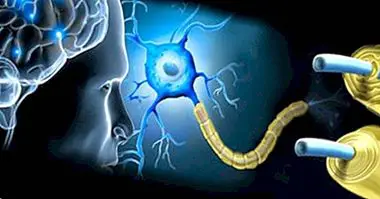State of shock: what is it and why is it produced?
They give us bad news: someone we love has died unexpectedly. We are pale, paralyzed, not knowing what to do and with a lost look.
They call us by our name, but we do not react. We do all these things because we are in a state of shock , and the printing of the news or event prevents us from processing the facts in a normal way. Our mind has been blocked, it is in a kind of limbo.
We are not talking about something infrequent: either for this or other reasons we sometimes have reactions or blockages of great intensity due to situations that we can not manage and that produce great anxiety. Let's analyze what it is, when it appears and what it means to enter into a psychological state of shock.
What is the state of shock?
The state of nervous shock is a intense emotional and physiological reaction to highly stressful and traumatic events that either just happened or we have met or processed at that time. These reactions can include anxiety, loss of consciousness, tunnel vision, dissociative symptoms, anger, anger, crying, nervous laughter, tremors, tachycardia or even complete indifference and lack of reaction.
The most usual thing is that or there is an affective dullness and loss of cognitive abilities or a hysterical reaction and / or aggressive to the fact.
Reaction to traumatic events: emotional shock
The state of shock It is an emotional shock that can occur for multiple reasons as long as these are very significant , both at the level of personal experience and observation or notification of an event.
While occasionally it may appear in positive circumstances that cause us great excitement (unexpected hiring, great achievements, fulfilling vital goals, winning the lottery, etc.), generally the state of shock appears in situations and traumatic and aversive events (For example, there are common reasons that we enter in a state of shock the death of a loved one, a rape, an accident, the loss of physical or mental faculties, a break or rejection of love or a dismissal).
It is important to keep in mind that the state of emotional shock it's a normal response, and not something pathological , which occurs in a transient way for a relatively short period of time (from minutes to several days). It is not something that has to do with an abnormal functioning of the body, since normally the state of shock appears in very unusual situations in which emotional involvement is justified.
What makes us enter this state?
We have already said that the trigger of the state of shock is a traumatic or very stressful event for us. But what conditions must this event itself have to appear?
As a general rule, as regards the event in question, it is considered that for a situation to generate a state of shock this it must be perceived as extremely harmful and painful for the subject (or the opposite if the shock is for something positive). That is, there is a situation in which our entire nervous system is activated to respond to a complex situation in which there is much at stake and in which we should respond quickly.
It also needs to be unexpected and that we do not have or believe we have decision power or control over it . Thus, we can consider that what causes the state of shock is the perception of the event rather than the event per se.
Being therefore the perception of the event what causes the psycho-emotional and physiological reaction own shock and taking into account that not everyone experiences this state in the same way in the same situations, it is undeniable that there must be internal variables of the person experiencing this phenomenon involved in experiencing the state of shock.
The configuration of neurotransmitters and neuronal structure, the type of personality and self-esteem, the previous experiences lived and the value given to the type of event that is considered traumatic are examples of characteristics that will affect whether or not a state of emotional shock, its intensity and the type of reaction that is going to unleash.
Shock and stress disorders
It is common to talk about going into a state of shock in situations where stress disorders appear. In fact, it could be considered that it would be a first step that can situate us between the experience of a traumatic event and the suffering or not suffering from a stress disorder, be it acute or post-traumatic.
This is because it is considered the emotional shock or state of shock a first phase, acute and impact, in the process of reacting to the traumatic event . In this situation the trauma has not yet finished processing, being the first reactions of disbelief and a direct reaction to know a certain event that we have not yet accepted.
This phase can last from a few minutes to a few days, being in this moment of initial shock the phase in which they usually appear the processes of denial of the event typical of mourning for a loss. Later a second one appears in which the continuation of the same previous symptoms appears, but this time beginning to assimilate the fact.
It is at this point that acute stress disorder could appear, in which the avoidance of similar or reminiscent situations would appear and a set of problems would be presented, such as the persistent reexperimentation of part of the event, hyperactivation or dissociative symptoms such as depersonalization. And if the symptoms persisted for more than three months, the diagnosis could be that of post-traumatic stress disorder.
Treating the state of shock
Being in a state of shock in a very painful situation is normal. It is a process by which it is necessary to pass and that will normally end up sending itself as the person integrates the event into their reality.
However, depending on the intensity of the reaction (for example, anxiety crisis may appear) or the absence of anxiety It can be helpful to manage the situation the accompaniment and psychological counseling in the first moments. If the reaction is very intense, relaxation and breathing techniques can be applied or a tranquilizer can even be administered. In this sense, the possibility of providing Psychological First Aid is very positive.
Bearing in mind that sometimes the shock comes from the notification of something unexpected, it is necessary to take into account how it is communicated and the type of person to whom it is communicated , requiring a different approach depending on the individual. For example, the emotional reaction can be smoothed if a bad news is given in a calm or close way, while delaying or precipitating it in excess can prolong the anguish and cause an anticipatory anxiety prior to the shock itself. Empathy is crucial in these cases.
Later can be worked to prevent the onset of acute or post-traumatic stress disorders , and in the case that these disorders appear, we would work on them and treat them appropriately (exposure techniques, cognitive restructuring and relaxation techniques are some of the most effective strategies).
Bibliographic references:
- American Psychiatric Association. (2013). Diagnostic and Statistical Manual of Mental Disorders. Fifth edition. DSM-V. Masson, Barcelona.



















